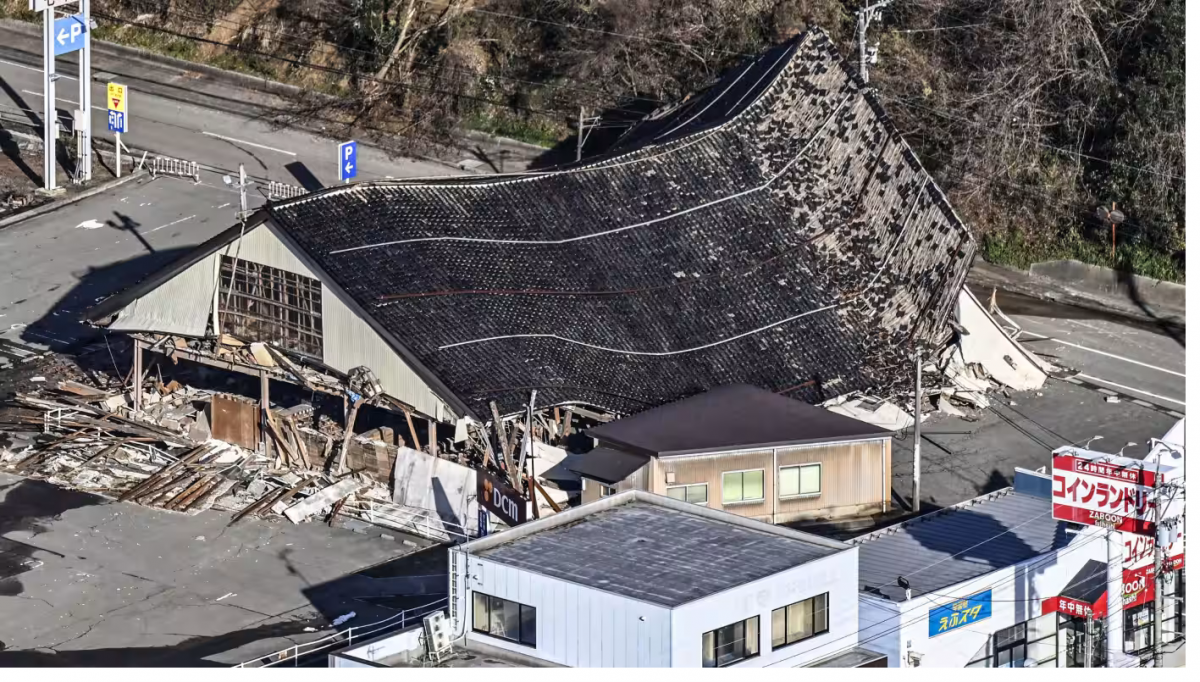WAJIMA, Japan, (Reuters) – At least 48 people were killed after a powerful earthquake hit Japan on New Year’s Day, with rescue teams struggling today to reach isolated areas where buildings had been toppled, roads wrecked and power cut to tens of thousands of homes.
The quake with a preliminary magnitude of 7.6 struck on Monday afternoon, prompting people in coastal areas to flee to higher ground as tsunami waves hit Japan’s western seaboard, sweeping cars and houses into the water.
A 3,000-strong rescue crew of army personnel, firefighters and police officers have been sent to the quake site on the Noto peninsula in Ishikawa prefecture.
“The search and rescue of those impacted by the quake is a battle against time,” Prime Minister Fumio Kishida said during an emergency meeting on Tuesday, donning a blue outfit commonly worn by officials during disaster relief operations.
Kishida said rescuers were finding it very difficult to access the northern tip of the Noto peninsula where helicopter surveys had discovered many fires and widespread damage to buildings and infrastructure. There are around 120 cases of people awaiting rescue, his government spokesperson said.
Many rail services and flights into the area have been suspended. More than 500 people were stranded at Noto’s airport which has closed due to cracks in its runway and access road and damage to its terminal building.
In Suzu, a coastal town of just over 5,000 households near the quake’s epicentre, up to 1,000 houses may have been destroyed, according to its mayor Masuhiro Izumiya.
“The situation is catastrophic,” he said.
Authorities have confirmed 48 fatalities, all in Ishikawa prefecture, making it Japan’s deadliest earthquake since at least 2016 when a 7.3 magnitude one struck in Kumamoto on the southern island of Japan, killing more than 220 people.
Many of those killed are in Wajima, a city on the remote northern tip of the Noto peninsula.
Scores more have been injured and authorities were battling blazes in several cities on Tuesday and hauling people from collapsed buildings.
“I’ve never experienced a quake that powerful,” said Wajima resident Shoichi Kobayashi, 71, who was at home having a celebratory New Year’s meal with his wife and son when the quake struck,sending furniture flying across the dining room.
“Even the aftershocks made it difficult to stand up straight,” he said, adding his family were sleeping in their car because they could not return to their badly damaged home.
Around 200 tremors have been detected since the quake first hit on Monday, according to the Japan Meteorological Agency, which warned more strong shocks could hit in the coming days.
WRECKED HOMES
Fujiko Ueno, a 73-year-old resident of Nanao city in Ishikawa, said nearly 20 people were in her house for a New Year celebration when the quake struck, splintering the walls which came crashing down on a parked car.
Miraculously, everyone emerged uninjured.
“It all happened in the blink of an eye” she said, standing next to the crushed car on a road littered with debris and mud that oozed out from cracks in its surface.
Several world leaders sent condolence messages with President Joe Biden saying in a statement the United States was ready to provide any necessary help to Japan.
The Japanese government ordered around 100,000 people to evacuate their homes on Monday night, sending them to sports halls and school gymnasiums, commonly used as evacuation centres in emergencies.
Almost half of those evacuated had returned to their homes on Tuesday after authorities lifted tsunami warnings.
But around 33,000 households remained without power in Ishikawa prefecture after a night when temperatures dropped below freezing, according to Hokuriku Electric Power’s 9505.T website. Nearly 20,000 homes have no water supply.
The Imperial Household Agency said it would cancel Emperor Naruhito and Empress Masako’s slated New Year appearance on Tuesday following the disaster. Kishida postponed his New Year visit to the Ise Shrine scheduled for Thursday.
Japan’s defence minister told reporters on Tuesday that 1,000 army personnel are involved in rescue efforts and that 10,000 could eventually be deployed.
NUCLEAR PLANTS
The quake also comes at a sensitive time for Japan’s nuclear industry, which has faced fierce opposition from locals since the 2011 earthquake and tsunami that triggered nuclear meltdowns in Fukushima. Whole towns were devastated in that disaster and nearly 20,000 people perished.
Japan last week lifted an operational ban imposed on the world’s biggest nuclear plant, Kashiwazaki-Kariwa, which has been offline since the 2011 tsunami.
The Nuclear Regulation Authority said no irregularities were found at nuclear plants along the Sea of Japan, including five active reactors at Kansai Electric Power’s 9503.T Ohi and Takahama plants in Fukui Prefecture.
Hokuriku Electric’s Shika plant, the closest to the epicentre, has also been idle since 2011. The company said there had been power outages and oil leaks following Monday’s jolt but no radiation leakage.
The company had previously said it hoped to restart the reactor in 2026.
Toshiba said its local subsidiary Kaga Toshiba Electronics has stopped semiconductor production at its plant in Ishikawa to gauge the quake’s impact on its facilities.
Chip equipment maker Kokusai Electric 6525.Tsaid it had found damage at its factory in Toyama and was investigating further ahead of the planned resumption of operations on Thursday.




